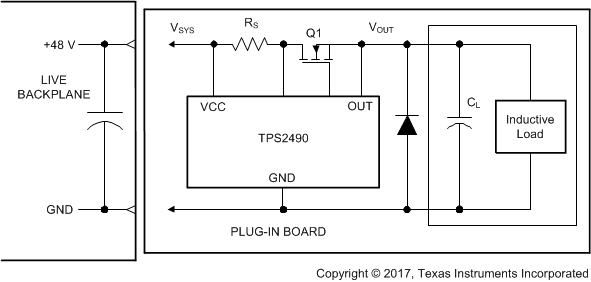JAJS177F November 2003 – February 2020 TPS2490 , TPS2491
PRODUCTION DATA.
- 1 特長
- 2 アプリケーション
- 3 概要
- 4 改訂履歴
- 5 Pin Configuration and Functions
- 6 Specifications
- 7 Detailed Description
- 8 Application and Implementation
- 9 Power Supply Recommendations
- 10Layout
- 11デバイスおよびドキュメントのサポート
- 12メカニカル、パッケージ、および注文情報
パッケージ・オプション
デバイスごとのパッケージ図は、PDF版データシートをご参照ください。
メカニカル・データ(パッケージ|ピン)
- DGS|10
サーマルパッド・メカニカル・データ
発注情報
10.1.2 System Considerations
A) Continued proper operation of the LM5069 hot swap circuit requires capacitance be present on the supply side of the connector into which the hot swap circuit is plugged in, as depicted in . The capacitor in the Live Backplane section is necessary to absorb the transient generated whenever the hot swap circuit shuts off the load current. If the capacitance is not present, inductance in the supply lines generate a voltage transient at shut-off which can exceed the absolute maximum rating of the TPS2490, resulting in its destruction.
B) If the load powered via the TPS2490 hot swap circuit has inductive characteristics, a diode is required across the TPS2490’s output. The diode provides a recirculating path for the load’s current when the TPS2490 shuts off that current. Adding the diode prevents possible damage to the TPS2490 as the OUT pin is taken below ground by the inductive load at shutoff. See Figure 27.
 Figure 27. Output Diode Required for Inductive Loads
Figure 27. Output Diode Required for Inductive Loads